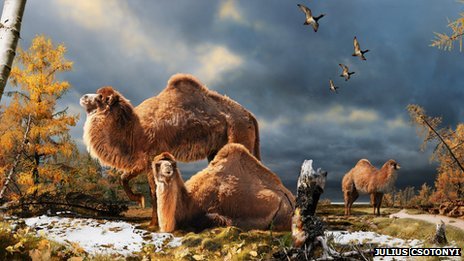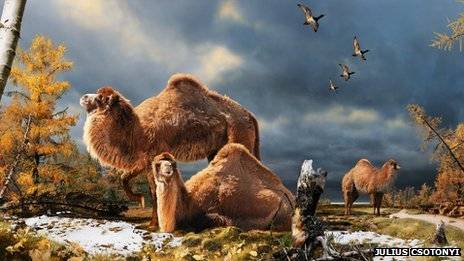Giant camel fossil found in Arctic
Source: bbc.co.uk
Camels are well known for their ability to survive the hot and dry conditions of the desert, but a study suggests they once thrived in colder climes.Scientists have unearthed the fossilised remains of a giant species of camel in Canada’s High Arctic.
An analysis of protein found in the bones has revealed that this creature, which lived about 3.5 million years ago, is an ancestor of today’s species.
The research is published in the journal Nature Communications.

The giant camels were thought to have lived about 3.5 million years ago and are believed to be direct ancestors of our modern species
Dr Mike Buckley, an author of the paper from the University of Manchester, said: "What’s interesting about this story is the location: this is the northernmost evidence of camels."
Cold conditions
The mid-Pliocene Epoch was a warm period of the Earth’s history - but surviving in the Arctic would have still been tough.
The ancient camels would have had to cope with long and harsh winters, with temperatures plunging well below freezing. There would have been snow storms and months of perpetual darkness.
Nonetheless, at this time, the polar region would have been covered in forest.
While scientists have known for some time that camels evolved in North America, with the earliest creatures dating to about 45 million years ago, they were astonished to find a species at such a high latitude.
Over the course of three expeditions, which began in 2006, researchers from the Canadian Museum of Nature collected 30 fragments of fossilised leg bone from Ellesmere Island in Canada.
Their size suggested that the animal was about 30% larger that today’s camels, measuring about 2.7m from foot to shoulder.
Despite its bulk, the researchers believe it would have been similar in appearance - although it probably had a shaggier coat to stay warm.
To investigate further, the team took collagen - the dominant protein found in bone - from the fossils, and compared this with collagen found in other fossils and modern animals.
Dr Buckley said: "These biomolecules tell us that it is a direct ancestor of modern camels."
He said the findings provided a new insight into the evolution of this animal.
"It suggests that many of the adaptations that we currently think of, in terms of camels being adapted to warm desert-like environments, could have actually originated through adaptation to quite the opposite extreme... cold, harsh environments," he explained.
The scientists believe that the camel’s hump (which stores fat, not water as is sometimes thought) could provide the reserves needed for an Arctic six-month winter.
Their large eyes would have helped them to see in the low light, and their flat feet would have been just as useful for walking on snow as they are on sand.
Article from: bbc.co.uk






















